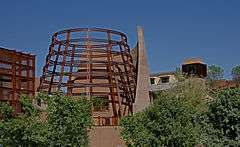Las Vegas Springs
|
Las Vegas Springs | |
|
Nevada Historical Marker #40 | |
|
The Desert Living Center rotunda at the Springs Preserve | |
| Location | Las Vegas, Nevada |
|---|---|
| Coordinates | 36°10′22″N 115°11′22″W / 36.17278°N 115.18944°WCoordinates: 36°10′22″N 115°11′22″W / 36.17278°N 115.18944°W |
| NRHP Reference # | 78001719 |
| MARKER # | 40 |
| Added to NRHP | December 14, 1978 |
The Las Vegas Springs or Big Springs[1] is the site of a natural oasis, known traditionally as a cienega. For more than 15,000 years, springs broke through the desert floor, creating grassy meadows (called las vegas by Mexican explorers).[2] The bubbling springs were a source of water for Native Americans living here at least 5,000 years ago.[3] Known as The Birthplace of Las Vegas it sustained travelers of the Old Spanish Trail and Mormons who came to settle the West.[1] The springs' source is the Las Vegas Aquifer.[4]
The springs are now a part of the Las Vegas Springs Preserve. Las Vegas Springs was once the site of three springs, running into two large pools of water. It is a site historically known for a gathering of pioneers and Native Americans and early settlers in the Las Vegas Valley. In 1905, it provided water source to the budding town and railroad. Once pipe lines were laid and wells were drilled, the surface water receded, making it the way it is today. The site is currently undergoing rehabilitation to protect what remains architecturally and archaeologically.[5]
Now, it is 180 acres of historic land located just west of Downtown Las Vegas. It is open to the public and more information can be found here: http://www.springspreserve.org/
History
The first non-Native American crossing Las Vegas Springs was Raphael Rivera in 1829. He was the Mexican scout for the expedition of Antonio Armijo who pioneered the Old Spanish Trail between New Mexico and California.[6] Later, American traveler John C. Fremont and Kit Carson camped at the springs in 1844.[1] The springs stopped flowing to the surface in 1962[7] as the water table dropped as more water was pumped out to meet the demands of a growing population than was being replaced by rainfall and snow melt.
Uncontrolled use of private wells and wasted water contributed to the early depletion of the aquifer. This forced the Las Vegas Land and Water Company to drill 'Well No. 1' in 1923[8] to supply the demands for water.
The springs and associated infrastructure have been listed on the National Register of Historic Places since 1978[9] and are marked as Nevada Historical Marker 40.
See also
References
- 1 2 3 "100 Years of Clark County - Big Springs". Las Vegas Review-Journal. 2009-01-31. p. 2B.
- ↑ "People & Events". American Experience. PBS Online. 2005-07-11. Retrieved 2008-08-25.
- ↑ "Las Vegas Springs Preserve - History, Gardens and Community". Retrieved 2008-08-25.
- ↑ "A REEVALUATION OF THE GROUND WATER BUDGET FOR LAS VEGAS VALLEY, NEVADA, WITH EMPHASIS ON GROUND WATER DISCHARGE". JAWRA Journal of the American Water Resources Association. 2007-06-08. Retrieved 2008-08-25.
- ↑ City of Las Vegas, Historic Locations > Big Springs/Las Vegas Springs
- ↑ http://www.lvol.com/lvoleg/hist/lvhist.html History of Las Vegas. Retrieved in April 25, 2012, to 12:10 pm.
- ↑ Ainlay, Thomas Taj; Judy Dixon Gabaldon (2003). Las Vegas: The Fabulous First Century. Arcadia Publishing. p. 121. ISBN 0-7385-2416-6.
- ↑ "LAS VEGAS TOWN SITE - 1905 to 1928".
- ↑ "National Register of Historic Places".
| Preceded by 39 Panaca |
Nevada Historical Markers 40 Las Vegas (The Meadows) |
Succeeded by 41 Pueblo Grande de Nevada |
